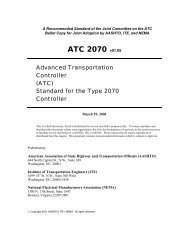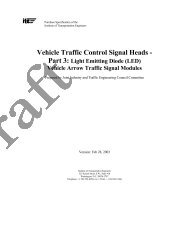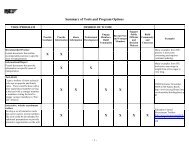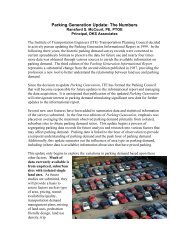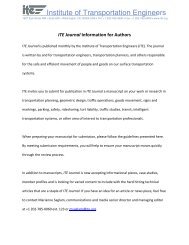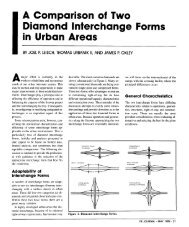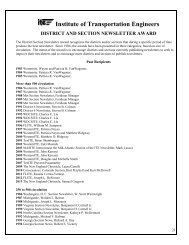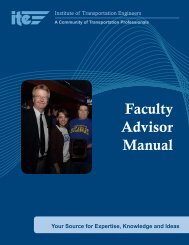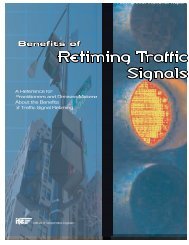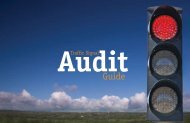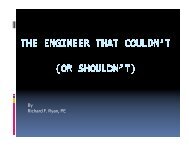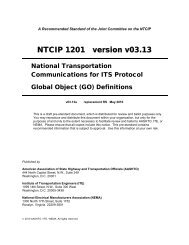Toolbox of Countermeasures and Their Potential Effectiveness to ...
Toolbox of Countermeasures and Their Potential Effectiveness to ...
Toolbox of Countermeasures and Their Potential Effectiveness to ...
You also want an ePaper? Increase the reach of your titles
YUMPU automatically turns print PDFs into web optimized ePapers that Google loves.
8<br />
<strong>Toolbox</strong> <strong>of</strong><br />
<strong>Countermeasures</strong> <strong>and</strong> <strong>Their</strong><br />
<strong>Potential</strong> <strong>Effectiveness</strong> <strong>to</strong><br />
Make Intersections Safer<br />
Introduction<br />
Studies included in the NCHRP 17-18 (3), Guidance for Implementation <strong>of</strong> the AASHTO Strategic<br />
Highway Safety Plan, as well as in other research by governmental entities have produced estimates<br />
<strong>of</strong> crash reductions that might be expected if a specified improvement or group <strong>of</strong> improvements<br />
are implemented.Three tables have been developed that attempt <strong>to</strong> summarize some <strong>of</strong> the available<br />
information. Readers will note that, by <strong>and</strong> large, there may be little consensus regarding the<br />
value <strong>of</strong> crash reduction fac<strong>to</strong>rs for a number <strong>of</strong> countermeasures.The transportation engineering<br />
discipline needs <strong>to</strong> develop a base <strong>of</strong> statistically sound before-<strong>and</strong>-after studies for extended<br />
periods <strong>of</strong> time <strong>to</strong> overcome the deficit in countermeasure effectiveness data.<br />
Use <strong>of</strong> the Tabular Data<br />
The data in this briefing sheet represent a number <strong>of</strong> countermeasure effectiveness studies <strong>and</strong><br />
includes ranges <strong>of</strong> effectiveness realized from one or more sources. Readers are encouraged <strong>to</strong><br />
obtain <strong>and</strong> review original source documents for more detailed information. It must be emphasized<br />
that the potential effectiveness values, for expample percentage reduction in crashes, represent<br />
order-<strong>of</strong>-magnitude estimates only. Traffic engineers need <strong>to</strong> consider site-specific environmental,<br />
geometric <strong>and</strong> operational conditions before making a judgment regarding those countermeasures<br />
that will be applied <strong>to</strong> an intersection.<br />
Traffic engineers <strong>and</strong> other transportation pr<strong>of</strong>essionals can use the information contained in this<br />
briefing sheet when the public or an elected or appointed <strong>of</strong>ficial asks a question such as:<br />
What is the range <strong>of</strong> solutions that might be considered at the signalized intersection <strong>of</strong> Maple<br />
<strong>and</strong> Elm streets due <strong>to</strong> the high number <strong>of</strong> <strong>to</strong>tal crashes <strong>and</strong> left-turn crashes?”What low-cost<br />
improvements can be tried first? If these improvements do not give us a higher degree <strong>of</strong> safety,<br />
what else can we try?<br />
The countermeasure effectiveness tables in this briefing package include:<br />
U.S. Department <strong>of</strong> Transportation<br />
Federal Highway Administration<br />
✦<br />
✦<br />
✦<br />
Table 1: Signalization <strong>Countermeasures</strong> at Signalized Intersections. Specific categories<br />
<strong>of</strong> countermeasures included in this table are signal timing <strong>and</strong> phasing improvements,<br />
signal hardware <strong>and</strong> combination signal <strong>and</strong> other improvements.<br />
Table 2: Geometric <strong>Countermeasures</strong> at Unsignalized Intersections. Specific categories<br />
<strong>of</strong> countermeasures included in this table are left-turn treatments, right-turn treatments<br />
<strong>and</strong> other geometric improvements.<br />
Table 3: Signs/Markings/Operational <strong>Countermeasures</strong> (Applicability Notes for<br />
Signalized <strong>and</strong>/or Unsignalized Intersections). Specific categories <strong>of</strong> countermeasures<br />
included in this table are: signs, pavement markings <strong>and</strong> modifications, <strong>and</strong> regula<strong>to</strong>ry, lighting<br />
<strong>and</strong> operational improvements.<br />
TOOLBOX OF COUNTERMEASURES April 2004<br />
1
<strong>Toolbox</strong> <strong>of</strong> <strong>Countermeasures</strong> <strong>and</strong> <strong>Their</strong> <strong>Potential</strong> <strong>Effectiveness</strong> <strong>to</strong> Make Intersections Safer<br />
Table 1:<br />
Signalization <strong>Countermeasures</strong> at Signalized Intersections<br />
Numbers in [n] indicate references used<br />
Numbers prior <strong>to</strong> the [n] represent the range <strong>of</strong> % crash reduction that might be expected from implementing a given improvement.<br />
<br />
Countermeasure/Crash Type identified; however no estimate <strong>of</strong> effectiveness is provided.<br />
<strong>Potential</strong> <strong>Effectiveness</strong><br />
(Percentage Reduction)<br />
Improvement Type(s) Cost Total Right Angle Left Turn Rear-end Sideswipe Pedestrian Red-Light Older<br />
Crashes Crashes Crashes Crashes Running Driver<br />
SIGNAL OPERATIONS IMPROVEMENTS<br />
Interconnect/Coordinate Medium 15-17 [1] 25-38 [12] [2]<br />
Traffic Signals; Optimization<br />
Increase/Modify Clearance Intervals Low 4-31 [1,9,10] 1-30 [1,9] [2]<br />
Improve Signal Timing (General) Low 10-15 [1] <br />
Add Protected/Permissive LT Phase Medium 4-10 [1,9] 40-64 [1,9]<br />
Use Green Arrow/ Protected Left Low 3 [9] 98 [9] <br />
Turns/Movement Signal Phasing<br />
Use Split Phases Low 25 [11] <br />
Use Leading Pedestrian Interval Low 5 [8]<br />
Add Pedestrian Phase Medium 23-25 [1] 7-60 [1,8]<br />
Add Left-Turn Phasing <strong>to</strong> an Medium 23-48 [6, 12] 63-70 [1] 5 [8]<br />
Existing Signal<br />
Provide Green Extension Variable <br />
(Advance Detection)<br />
Install Signal Actuation Variable <br />
Assume Slower Walking Speeds for Low <br />
Pedestrian Signal Timing<br />
Provide Advance Warning <strong>of</strong> Signal Medium <br />
Changes at Rural Signalized<br />
Intersections<br />
Remove Signals from Late Night/Early Low 29 [9] 80 [9]<br />
Morning Flash<br />
Consider Restricting Right-Turns- Low <br />
on-Red<br />
Consider Installation <strong>of</strong> Pedestrian Low <br />
Countdown Signals<br />
(incremental cost)<br />
Consider Installation <strong>of</strong> Animated Low <br />
Eye Signals (Incremental cost)<br />
SIGNAL HARDWARE<br />
Install Larger (12-Inch) Signal Lenses Low 10-12 [1,9] 48 [9] <br />
Install Flashing Beacon at Intersection Medium 30-38 [1]<br />
Install Flashing Beacon at Advance Medium 25-28 [1] [2]<br />
<strong>of</strong> Intersection<br />
Replace Pedestal Mounted Signal High 28-43 [12] <br />
with Mast Arm<br />
Install Backplates on Existing Signals Low 2-24 [1,9] 7-93 [1,5,9] [2] <br />
Optically Programmed Signal Lenses 15-18 [1] <br />
Provide Louvers,Visors, Special Lenses Low <br />
so Drivers are able <strong>to</strong> View Signals<br />
only for their Approach<br />
Upgrade Signal Controller Medium 20-22 [1 8, 11] <br />
Relocate/Shield Signal Hardware in Medium [6] <br />
Clear Zone. Signal Hardware<br />
Should Not Obstruct Sight Lines.<br />
Install Additional Signal Heads Medium 10 [9] 42 [9] <br />
Install More Overhead Traffic Signals High <br />
Provide Two Red-Signal Displays Medium [2]<br />
within each Signal Head <strong>to</strong> Increase<br />
Conspicuity <strong>of</strong> the Red Display<br />
Use LED Traffic Signal Module. Medium [2]<br />
Stripe for Left-Turn Lane within Low 26 [9] 66 [9]<br />
Existing Roadway<br />
Red T-Display Medium 9 [9] 36 [9]<br />
2<br />
TOOLBOX OF COUNTERMEASURES April 2004
<strong>Toolbox</strong> <strong>of</strong> <strong>Countermeasures</strong> <strong>and</strong> <strong>Their</strong> <strong>Potential</strong> <strong>Effectiveness</strong> <strong>to</strong> Make Intersections Safer<br />
Table 1 (continued)<br />
Signalization <strong>Countermeasures</strong> at Signalized Intersections<br />
<strong>Potential</strong> <strong>Effectiveness</strong><br />
(Percentage Reduction)<br />
8<br />
Improvement Type(s) Cost Total Right Angle Left Turn Rear-end Sideswipe Pedestrian Red-Light Older<br />
Crashes Crashes Crashes Crashes Running Driver<br />
COMBINATION SIGNAL AND OTHER IMPROVEMENTS<br />
Construct Left-Turn Lanes with High <br />
Signal Upgrades<br />
Left-Turn Lane, Signal <strong>and</strong> NO High 21-25 [1] 46-54 [1] <br />
Turn Phase<br />
Left-Turn Lane, Signal PLUS High 25-36 [1] 43-45 [1] <br />
Turn Phase<br />
Add Left-Turn Phasing AND Turn High 46-69 [12] <br />
Lanes <strong>to</strong> an Existing Signal<br />
Removal Signal, Develop a Program Low 50-53 [1] <br />
<strong>to</strong> Identify <strong>and</strong> Remove<br />
Unwarranted Signals.<br />
Install 12” Signal Heads <strong>and</strong> SIGNAL Low 11 [9] 36 [9]<br />
ISSUE BRIEF<br />
Table 2:<br />
Geometric <strong>Countermeasures</strong> at Unsignalized Intersections<br />
Table 2 (continued on page 4)<br />
<strong>Potential</strong> <strong>Effectiveness</strong><br />
(Percentage Reduction)<br />
Improvement Type/Special User Cost Total Right Angle Left Turn Rear-end Sideswipe Older<br />
Crashes<br />
Driver<br />
LEFT TURN TREATMENTS<br />
Add Left-Turn Lane, No Signal Medium-High 25-41 [1,9] 50-86 [1,9]<br />
Provide Separate Left-Turn Lane, Medium 44/rural <br />
One Major Road Approach, <strong>and</strong> 33/urban [5]<br />
3-Leg Intersection.<br />
Provide Separate Left-Turn Lane, Medium 28/rural <br />
One Major Road Approach, <strong>and</strong> 27/urban [5]<br />
4-Leg Intersection.<br />
Provide Separate Left-Turn Lane, High 42 [5]<br />
2 Major Road Approaches<br />
Provide Adequate Length Turn Lane Medium 15-30 [1,7,10] <br />
Provide Indirect Left Turns Variable <br />
Provide Offset Left Lanes Variable [1]<br />
Provide Left-Turn Acceleration Lane Medium-High<br />
at Divided Highway Intersections<br />
<br />
Add Continuous Left-Turn Lanes High [1]<br />
RIGHT-TURN TREATMENTS<br />
Provide Right-Turn Lane, One Major Medium 14 [5, 10] <br />
Approach, on Rural 4-Lane, Intersection<br />
Exclusive Right-Turn Lanes,Two Major Variable 14-27 [5] <br />
Approaches, on Rural 4-Lane, Intersection<br />
Provide Right-Turn Acceleration Lanes Variable <br />
Provide Longer Right-Turn Lane Variable <br />
Provide Offset Right-Turn Lane Variable [1]<br />
Add Right-Turn Lane Medium 24-30 [1]<br />
TOOLBOX OF COUNTERMEASURES April 2004 3
<strong>Toolbox</strong> <strong>of</strong> <strong>Countermeasures</strong> <strong>and</strong> <strong>Their</strong> <strong>Potential</strong> <strong>Effectiveness</strong> <strong>to</strong> Make Intersections Safer<br />
Table 2 (continued)<br />
Geometric <strong>Countermeasures</strong> at Unsignalized Intersections<br />
<strong>Potential</strong> <strong>Effectiveness</strong><br />
(Percentage Reduction)<br />
Improvement Type/Special User Cost Total Right Angle Left Turn Rear-end Sideswipe Older<br />
Crashes<br />
Driver<br />
OTHER/GEOMETRIC IMPROVEMENTS<br />
Shoulder Bypass Lanes; Rural Intersections. Low <br />
Move Intersection Away from Curve. High 25 [1,7,8] <br />
Horizontal/Vertical Realignment High [7]<br />
<strong>of</strong> Approaches.<br />
Raised Medians Near Major Intersections. Medium-High 25 [6,1,7,8]<br />
Continuous Two-Way Left-Turn Lanes <strong>to</strong> High 30-40 [1,7,8] <br />
Separate Left Turn <strong>and</strong> Through Traffic<br />
Convert 4-Leg <strong>to</strong> Two, 2-T Intersections High 57 [5,10]<br />
Convert Two-T Intersections <strong>to</strong> One 4-Leg. High [7]<br />
Close or Relocate High Risk Intersections Variable 100 [7]<br />
Full Width Paved Shoulders. No Shoulder Variable 2.8% per ft. <strong>of</strong> <br />
Width Less than 8 ft.<br />
additional shoulder<br />
width [7]<br />
Install Splitter Isl<strong>and</strong>s on the Minor Road Medium NCOE [7]<br />
Approach where the Intersection or<br />
STOP Sign is not Visible <strong>to</strong> Mo<strong>to</strong>rists.<br />
Remove Intersection Skew Angle (<strong>of</strong> less High 40-50, [1,10]<br />
than 80 degrees); Realign Intersection<br />
Increase Curb Turning/Edge <strong>of</strong> Pavement Radii Medium 15-21 [1,7] [1]<br />
Widen Approaches <strong>to</strong> H<strong>and</strong>le Turns Medium [7] <br />
Roundabouts at Appropriate Locations High 38,Total Crashes<br />
76, Injuries<br />
90, Fatalities [7]<br />
Clear Sight Triangle on S<strong>to</strong>p or Yield Low [7] <br />
Controlled Approaches<br />
Clear Sight Triangle in the Medians <strong>of</strong> Low [7]<br />
Divided Highways Near Intersections<br />
<br />
Countermeasure/Crash Type identified; however no estimate <strong>of</strong> effectiveness is provided.<br />
Table 3:<br />
Signs/Markings/Operational <strong>Countermeasures</strong> Applicability<br />
Noted for Signalized <strong>and</strong>/or Unsignalized Intersections<br />
<strong>Potential</strong> <strong>Effectiveness</strong><br />
(Percentage Reduction)<br />
Improvement Type Applicability Cost Total Right Rear Side- Pedestrian Red-Light Older<br />
Crashes Angle End swipe Running Adults<br />
SIGNS<br />
Install SIGNAL AHEAD Sign Signalized Intersection Low 3-40 [7,9, 11] 35 [9] [2]<br />
Install LEFT TURN Signal Sign Signalized Intersection Low [2]<br />
Install SLIPPERY WHEN WET Sign Signalized Intersection Low [2]<br />
Enhanced Signing <strong>and</strong> Delineation Unsignalized Intersection Low [7] <br />
Supplementary STOP Signs Unsignalized Intersection Low [7] <br />
Mounted Over the Roadway<br />
Install YIELD TO PEDESTRIAN Sign Undefined Low 10 [8]<br />
PAVEMENT MARKINGS/MODIFICATIONS<br />
Install Raised Pavement Markings Undefined 6-13 [1] <br />
20-30 (Night)<br />
20-46 (Wet, Night)<br />
Use Wider Pavement Markings Undefined <br />
Install Rumble Strips on Undefined 2-44 [1]; NCOE [7] <br />
Intersection Approaches<br />
4<br />
TOOLBOX OF COUNTERMEASURES April 2004
<strong>Toolbox</strong> <strong>of</strong> <strong>Countermeasures</strong> <strong>and</strong> <strong>Their</strong> <strong>Potential</strong> <strong>Effectiveness</strong> <strong>to</strong> Make Intersections Safer<br />
Table 3 (continued)<br />
Signs/Markings/Operational <strong>Countermeasures</strong> Applicability Noted for Signalized <strong>and</strong>/or<br />
Unsignalized Intersections<br />
<strong>Potential</strong> <strong>Effectiveness</strong><br />
(Percentage Reduction)<br />
8<br />
Improvement Type Applicability Cost Total Right Rear Side- Pedestrian Red-Light Older<br />
Crashes Angle End swipe Running Adults<br />
PAVEMENT MARKINGS/MODIFICATIONS (continued)<br />
Resurfacing Undefined 7-59 [1];<br />
W, 40-54 [1]<br />
Add S<strong>to</strong>p Bars/Crosswalks Signalized Intersection 10-25 [10] <br />
Install Raised Crosswalk Undefined 8 [8]<br />
Groove Pavement for Skid Resistance Undefined 1-65 [1];25[11] <br />
Wet- 42-75 [1]<br />
Angled Median Crosswalk Undefined Medium 12 [8]<br />
Add S<strong>to</strong>p bars,Wider S<strong>to</strong>p Bar on Undefined 10-27 [1,9, 11,13] [5]<br />
the Minor Road Approach; <strong>and</strong> 47 [9]<br />
Short Segments <strong>of</strong> Centerlines<br />
Move Vehicle S<strong>to</strong>p Line Farther Signalized Intersection Low <br />
Back from Crosswalk AND Add<br />
Sign STOP HERE FOR<br />
PEDESTRIANS<br />
STOP AHEAD <strong>and</strong> STOP Messages Undefined Low 6 [9] [5]<br />
on Pavement 30 [9]<br />
Add Centerlines, S<strong>to</strong>p Bars <strong>and</strong> Unsignalized Low 45 [9] 67 [9]<br />
Replace 24 in. STOP Signs<br />
Double Indicated STOP Signs Unsignalized Low 11 [9] 36 [9]<br />
Add Centerlines <strong>and</strong> Move S<strong>to</strong>p Unsignalized Low 29 [9] 24 [9]<br />
Bars <strong>to</strong> Extended Curb Lines.<br />
Add Centerlines, Move STOP Bars Unsignalized Low 9 [9] 0 [9]<br />
<strong>to</strong> Extend Curb Lines, <strong>and</strong> Add<br />
Double-Indicated STOP Signs<br />
Provide Dashed Pavement Lining <strong>to</strong> Undefined Low [1]<br />
Guide Left-Turning Vehicles<br />
Through Selected Intersections<br />
Signed <strong>and</strong> Marked Crosswalks. Unsignalized Intersection Low 25-48 [1] <br />
For Greatest <strong>Effectiveness</strong>,<br />
Include Curb Ramps, Curb<br />
Extensions<br />
Use Rumble Strips Prior <strong>to</strong> Rural Rural, Low 35 [8]<br />
STOP Signs<br />
Unsignalized Intersection<br />
Rumble Strips <strong>and</strong> SIGNAL AHEAD Signalized Intersection Medium [2]<br />
Warning Sign <strong>and</strong> Pavement<br />
Marking with Message SIGNAL<br />
AHEAD<br />
Replace YIELD Signs with STOP Signs Unsignalized Low 29 [9] 9 [9]<br />
REGULATORY<br />
2-Way <strong>to</strong> Multi-Way S<strong>to</strong>p Unsignalized Intersection Low 53-74 [4,9,11] 84 [9] <br />
Restrict/Eliminate RTOR Signalized Intersection Low 20-25 [1] <br />
Eliminate Parking that Restricts Undefined Low 8-90<br />
Sight Distance [1, 7, 11]<br />
Restrict Driveways Near Unsignalized Intersection Low [1,7]<br />
Intersections; Right Turn In <strong>and</strong> Signalized Intersection<br />
Out Movements Only<br />
Allow Left Turns In, but Prohibit Unsignalized Intersection Low [1,7]<br />
Left Turns Out at Selected Access Signalized Intersection<br />
Points (Access Management)<br />
ISSUE BRIEF<br />
Table 3 (continued on page 6)<br />
TOOLBOX OF COUNTERMEASURES April 2004 5
<strong>Toolbox</strong> <strong>of</strong> <strong>Countermeasures</strong> <strong>and</strong> <strong>Their</strong> <strong>Potential</strong> <strong>Effectiveness</strong> <strong>to</strong> Make Intersections Safer<br />
Table 3 (continued)<br />
Signs/Markings/Operational <strong>Countermeasures</strong> Applicability Noted for Signalized <strong>and</strong>/or<br />
Unsignalized Intersections<br />
<strong>Potential</strong> <strong>Effectiveness</strong><br />
(Percentage Reduction)<br />
Improvement Type Applicability Cost Total Right Rear Side- Pedestrian Red-Light Older<br />
Crashes Angle End swipe Running Adults<br />
LIGHTING<br />
Improve Visibility <strong>of</strong> the Intersection Unsignalized Intersection Medium 19-75 [1, 7, 8] <br />
by Providing Lighting Signalized Intersection Night- 18-70 [1]<br />
Improve Visibility <strong>of</strong> the Existing Undefined Medium 25-50 [1]<br />
Rural Intersections <strong>and</strong> Urban N-42-50 [1] <br />
Corridors by Providing Lighting<br />
OPERATIONAL<br />
Add Signal <strong>to</strong> a Unsignalized Unsignalized High 20-45 [1,9] 68 [9]<br />
Intersection when Warranted<br />
Add Raised Medians Near Undefined 25 [1,10,12] <br />
Intersections<br />
Install Flashing Beacons Unsignalized Intersection [1] <br />
Improve Access Control Near Unsignalized Intersection [1]<br />
Intersections<br />
Signalized Intersection<br />
Refuge Isl<strong>and</strong>s Undefined 56 [8]<br />
Pedestrian Overpasses/Underpasses Unsignalized Intersection High 13 [8]<br />
Midblock 90-95 [1]<br />
Mid-block Traffic Signal Midblock High 52 [8]<br />
Far-side Bus S<strong>to</strong>ps<br />
Unsignalized Intersection<br />
Signalized Intersection 1 [8]<br />
Install Raised Medians Unsignalized Intersection Medium 69 [8]<br />
Signalized Intersection<br />
Speed Reduction <strong>and</strong> Enforcement Unsignalized Intersection High 70 [8]<br />
Signalized Intersection<br />
Cut Back Vegetation, Embankments Unsignalized Intersection [5]<br />
as Far as Possible at Existing S<strong>to</strong>p- Signalized Intersection<br />
Signed Controlled Intersections<br />
<br />
Countermeasure/Crash Type identified; however no estimate <strong>of</strong> effectiveness is provided.<br />
References<br />
1. Agent, Kenneth R. et. Al. Development <strong>of</strong><br />
Accident Reduction Fac<strong>to</strong>rs. Research Report<br />
KTC-96-13. Kentucky Transportation Center<br />
College <strong>of</strong> Engineering, June 1996.<br />
2. Institute <strong>of</strong> Transportation Engineers.<br />
Engineering <strong>Countermeasures</strong> <strong>to</strong> Reduce Red-<br />
Light Running.Washing<strong>to</strong>n, DC: ITE, 2003.<br />
http://safety.fhwa.dot.gov/rlr/rlrreport/<br />
RLRbook.pdf<br />
3. FHWA Older Driver H<strong>and</strong>book.<br />
4. Harwood, D.W., F. M. Council, E. Hauer,W. E.<br />
Hughes, <strong>and</strong> A.Vogt. Prediction <strong>of</strong> the Expected<br />
Safety Performance <strong>of</strong> Rural Two-Lane Highways,<br />
Report No. FHWA-RD-99-207.Washing<strong>to</strong>n,<br />
DC: Federal Highway Administration, 2000.<br />
5. Institute <strong>of</strong> Transportation Engineers. Traffic<br />
Safety <strong>Toolbox</strong>: A Primer on Traffic Safety.<br />
Washing<strong>to</strong>n, DC: ITE, 1999.<br />
6. NCHRP 17-18 (3). Initial Draft Compendium<br />
<strong>of</strong> Strategies, Signalized Intersections, Phase<br />
II. Draft April 29, 2002.<br />
7. NCHRP, 500. Volume 5: A Guide for Addressing<br />
Unsignalized Intersection Collisions.<br />
http://gulliver.trb.org/publications/nchrp/<br />
nchrp_rpt_500v5.pdf<br />
8. MetroPlan Orl<strong>and</strong>o. Orl<strong>and</strong>o Urban Area<br />
Arterial Pedestrian Crash Study. Orl<strong>and</strong>o:<br />
MetroPlan Orl<strong>and</strong>o, July 12, 2000.<br />
9. Polanis, Stanley F. Low Cost Safety<br />
Improvements. City <strong>of</strong> Wins<strong>to</strong>n-Salem, North<br />
Carolina, November 2003.<br />
10. Retting. R. M. Greene. Influence <strong>of</strong> Traffic Signal<br />
Timing on Red-Light Running <strong>and</strong> <strong>Potential</strong><br />
Vehicle Conflicts at Urban Intersections,<br />
Transportation Research Record 1595.<br />
Washing<strong>to</strong>n, DC:TRB, 1997.<br />
11. SEMCOG. Traffic Safety Manual, Second<br />
Edition. September 1997.<br />
http://www.semcog.org/TranPlan/Traffic<br />
Safety/assets/Safety_Manual.pdf<br />
12. Thomas, Gary B. <strong>and</strong> Daniel J. Smith.<br />
<strong>Effectiveness</strong> <strong>of</strong> Roadway Safety Improvements,<br />
Final Report. Highway Division <strong>of</strong> the Iowa<br />
Department <strong>of</strong> Transportation, CTRE<br />
Management Project 00-61, March 2001.<br />
13. TEXDOT 1995.<br />
Other References<br />
Consulted<br />
Pedestrian-Bicycle Information Center Web<br />
site. http://www.walkinginfo.org<br />
South Dakota Department <strong>of</strong> Transportation.<br />
Development <strong>of</strong> South Dakota Accident Reduction<br />
Fac<strong>to</strong>rs: SD 98-13,August 1998.<br />
http://www.state.sd.us/Applications/HR19R<br />
esearchProjects/Projects/SD1998_13_final_<br />
report.pdf<br />
6<br />
TOOLBOX OF COUNTERMEASURES April 2004



